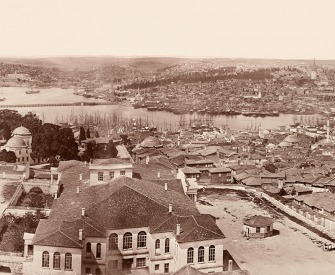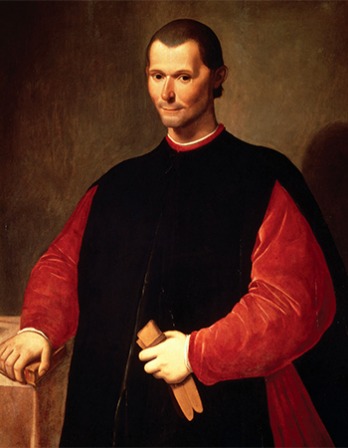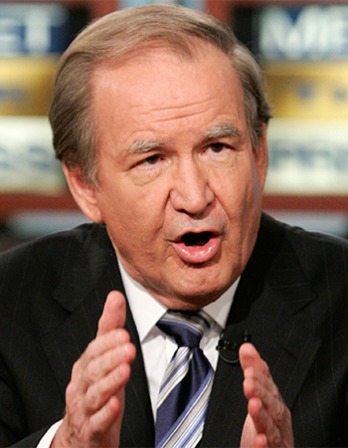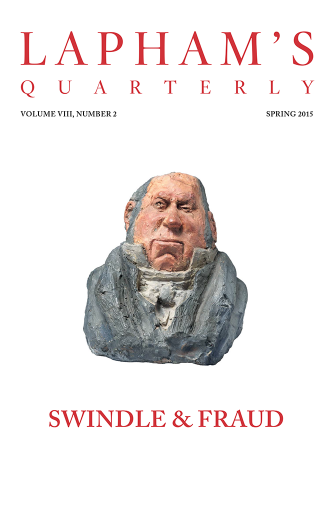Today’s city is the most vulnerable social structure ever conceived by man.
—Martin Oppenheimer, 1969A Matter of Optics
Rulers of cities have always had an interest in visibility, both in representing their power and in controlling people by seeing them.
By Warren Breckman

Bird’s-eye view of Rome, by Matthus Merian, c. 1641.
In the evening, “with the odor of the elephants after the rain and the sandalwood ashes growing cold in the braziers,” Kublai Khan despairs of ever knowing or understanding the empire he has built. And in the dusk, the Venetian Marco Polo tells the great Khan of the unknown cities he rules. So begins Italo Calvino’s Invisible Cities, that mystifying, illuminating, bedazzling compendium of fantastical places. Among these imagined cities, Polo tells the emperor of Irene. “Irene is the city visible when you lean out from the edge of the plateau at the hour when the lights come on, and in the limpid air, the pink of the settlement can be discerned spread out in the distance below…Those who look down from the heights conjecture about what is happening in the city; they wonder if it would be pleasant or unpleasant to be in Irene that evening. Not that they have any intention of going there (in any case the roads winding down to the valley are bad), but Irene is a magnet for the eyes and thoughts of those who stay up above.”
People love vantage points from which they can take in the city. Gustave Flaubert’s Madame Bovary does not observe Rouen from the street, but from a hilltop, where seen from above, “the whole landscape had the static quality of a painting.” William Wordsworth paused on Westminster Bridge in 1802 to observe London laid out before him:
This city now doth, like a garment, wear
The beauty of the morning; silent, bare,
Ships, towers, domes, theaters, and temples lie
Open unto the fields, and to the sky;
All bright and glittering in the smokeless air.
Tall towers have always delighted, because they provide such visions of the city spread out before the gaze. Where towers or hills failed, medieval or Renaissance painters imagined the city from on high, in a celestial view that no human eye had yet achieved. Technology eventually caught up to this desire. A straight line can be drawn from Félix Nadar’s first aerial photographs of Paris taken from his balloon in 1858 to my ability to google views of my city, my house, or my backyard from outer space.
The god’s-eye perspective is the ultimate expression of the human desire to make the city visible, to see it in a glance, to read it as an intelligible and unified object of human making. Yet, as Marco Polo tells Kublai Khan, those on the plateau cannot know Irene, for, “If you saw it, standing in its midst, it would be a different city; Irene is a name for a city in the distance, and if you approach, it changes.” City dwellers do not live in balloons or satellites, nor do they remain fixed in towers. In the streets, among the crush of people, clarity of view can yield to opacity, the distancing abstractions of vision give way to arousal of the body’s five senses through smells, sounds, sights, and surfaces. In the city’s labyrinth, invisibility can quickly trump visibility.
Much of the history of the city—its built forms and its politics, the urban experience, and the characteristic moral ambivalence that cities arouse—can be written as a tension between the visible and the invisible. What and who gets seen? By whom? Who interprets the city’s meaning? What should remain unseen?
Rulers of cities have always had an interest in visibility, both in representing their power and in controlling people by seeing them. The earliest cities emerged out of the symbiosis of religion and political power, and the temple and the citadel gave early urbanism its most visible elements. In the great Sumerian town of Ur, the kings built a towering ziggurat to display their devotion to the city’s patron god. A ziggurat rose in Babylon, possibly the Babel of scripture, “a tower, whose top may reach to heaven,” as the Book of Genesis relates in a primordial warning to all overzealous civic boosters. Jehovah’s jealous reaction to the Tower of Babel was just one of several inflictions He directed against cities. Not surprising, Jehovah’s ambivalence toward prideful urbanites. After all, an omnipotent God who has to be everywhere is unlikely to take up permanent residence anywhere. By contrast, in the more flexible and localized world of polytheism, cities were thought of as homes of the gods. Architectural and sculptural symbols made that visibly clear. Indeed, entire cities could be conceived as images of the universe, the placement of buildings and the alignment of streets instructing people on the shape of the cosmos even while delighting the gods by mirroring the divine order. An Egyptian holy text intones that the mission of a city founder was “to put the gods in their shrines.” The great Roman historian Livy said of Rome’s historic center, “The gods inhabit it.”
If temples housed the gods, citadels housed kings, and kings concentrated in their person the unity of the community. This form of incarnation could bestow divine status on the ruler, and in such cases the citadel fused political and sacred functions. Egyptian pharaohs—in life rulers and mediators between gods and humans and in death gods—founded new cities to honor themselves and even created entire necropolises, symbolic cities to accompany them into the afterlife. The Greeks drew much from Egypt, but in the flourishing period of the city-states, never this deification of rulers. Still, the citadel remained paramount, as did the mixing of the sacred and the political. The Greek word “polis”—the etymological root that nurtured so many English words designating the communal life of people—initially signified the fortress that sheltered people from threats. Only later did it come to refer to the people who used the fortress, and eventually to the entire communal life of this people. The acropolis, the city summit in Athens and numerous other Greek cities, clustered municipal and sacred buildings on the highest ground, because there the citizens found not only the best defense but also a landscape whose natural mysteries bespoke the presence of the gods.
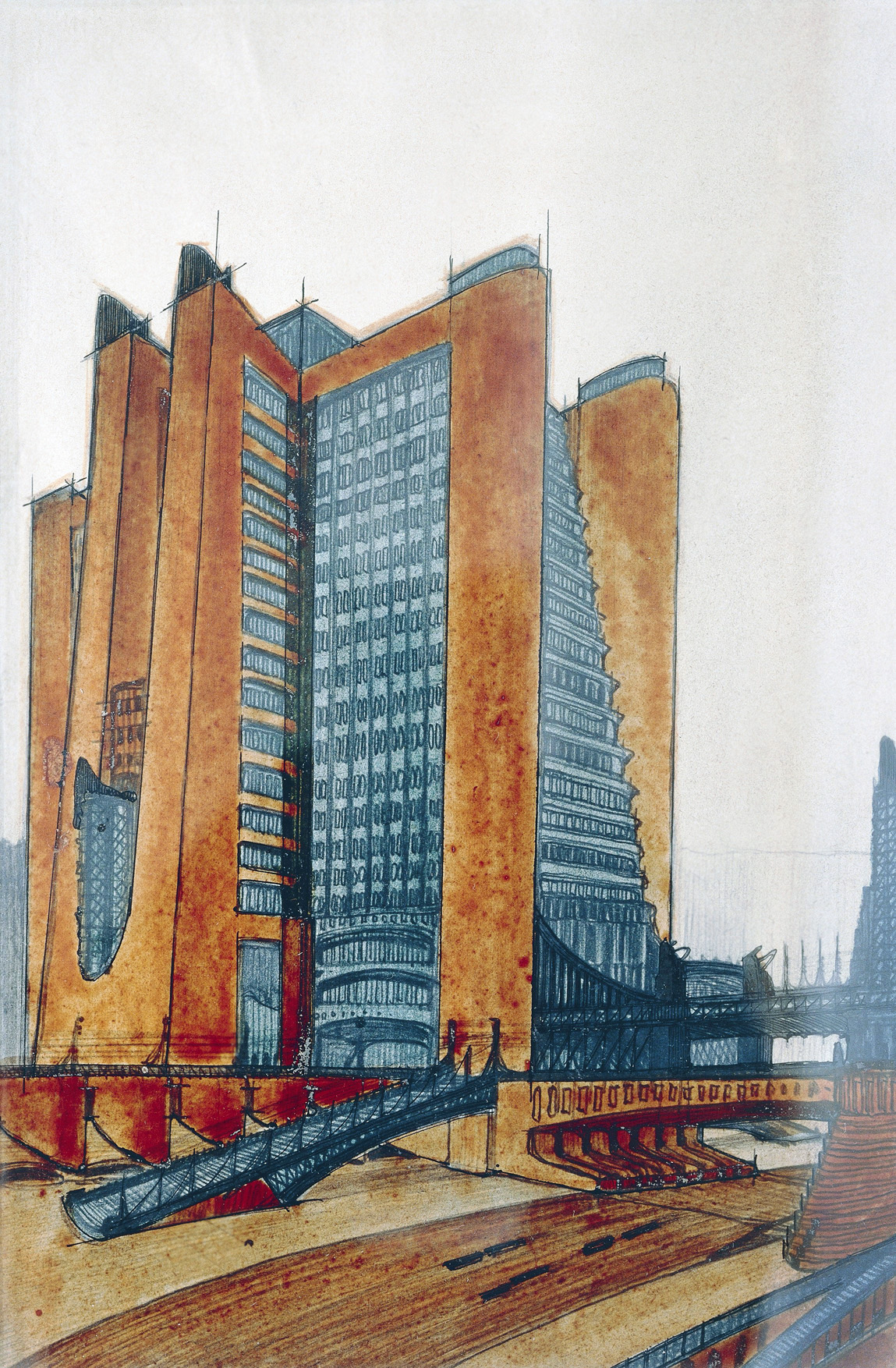
The New City, by Antonio Sant’Elia, 1914. Private Collection, Rome
Aristotle once argued that outside the city there are only beasts and gods: the polis is the natural place for the human animal. And for the Greeks there was no city without an agora. When the Greek invaders reached the shores below Troy’s ramparts, Homer relates, they formed an agora amid their beached ships, a space for deliberations and the altars of their gods. The agora in the actual city was what a twenty-first-century urban planner might call a “mixed-use” space. It combined, at times very uneasily, the marketplace and the assembly place for citizens. Under the brilliant Aegean sun, the agora was the theater for the chief scenes of city life. In the most famous of agoras, that of Athens, the citizen—member of a small minority within a population of women, slaves, and foreigners—might in a day fend off a zealous merchant, feel puzzled by Socrates’ relentless questions, and deliberate in a legal case. The Roman forum borrowed heavily from Greek urban form, combining in a sense both agora and acropolis in one precinct. Yet the needs of a great imperial capital demanded a rather different kind of visibility, a public space not only where one could be both actor and spectator, but where power could display itself. Hence, that great arbiter of Roman architecture, Vitruvius, specified that the size of the forum should not be too small, lest it cramp the assembled crowd, but not too large, lest empty space should underscore a poor turnout. With the right proportions, Vitruvius advised, the forum will be “adapted to the purpose of spectacles.” At more distant removes, the piazza, plaza, grand place, and town square are all descendents of the agora and the forum.
The Christian city of the Middle Ages retained many elements of its pagan ancestors, such as the town square. But the specific organization of power in medieval society created new features in the urban scene. As enunciated in the papal bull “Unam Sanctam” in 1302, the Catholic Church claimed to wield two swords, the spiritual and temporal. The Church never successfully achieved this universal control over worldly government, however—and in actual fact, two intertwined yet distinct and frequently rivalrous powers ruled over people. This division between secular and ecclesiastical authorities inevitably shaped the topography of the city. The divided powers required two distinct centers: a church or cathedral and its associated buildings for the spiritual sword, and depending on local political arrangements, a royal residence or a city hall, or both for its worldly correlate. As in the medieval Muslim city, where the mosque dominated the visual and symbolic topography, in its Christian counterpart, the church was the most important building of all. Its glorious spires rose above all other structures, and its shining form reaching to heaven was the first thing that the approaching traveler would see. In the labyrinth of the city streets, the church might momentarily disappear from sight, but already around the next corner it would burst into view again. And those streets were frequently the theater for processions and pageants that furthered the visibility, the readability of this social and religious order. Listen to the painter Albrecht Dürer’s recollection from 1520: “On the Sunday after our dear Lady’s Assumption, I saw the great procession from the Church of our Lady at Antwerp, when the whole town of every craft and rank was assembled, each dressed in his best according to his rank. And all ranks and guilds had their signs, by which they might be known.”
The picture of medieval urbanism would be incomplete without the defensive walls that typically girded the city. Walls created a dramatic line separating the town from the surrounding territory. The city gate became a potent symbol of the inhabitants’ power to open or close themselves to the world at will. In a context where the world out there was full of threats, the old German saying, “City air makes you free,” referred not only to cities’ relative independence within feudal society, but also to the freedom that came with security behind a tall wall.
As European monarchs from the sixteenth to the eighteenth centuries forged the dispersed powers of the old feudal order into the sword of unified sovereignty, many cities lost much of their autonomy and, gradually, their walls, as centralized states increasingly took over the functions of military defense. With that, they had to yield to the monarch’s need for awesome projections of his power. The broad avenue, the radial patterning of streets and squares, the long perspective leading the eye toward a triumphal arch or magnificent statue furnished the idiom of city planning in the age of absolutism. Louis XIV, the Sun King, may have situated his grandest presentation of self in the suburb of Versailles, but he knew he needed a capital city cut to his measure. One of his chief ministers, Jean-Baptiste Colbert, understood well the task of refitting Paris with boulevards and monumental statuary. “Nothing,” he noted, “marks the greatness of princes better than the buildings that compel people to look at them in awe.” It is ironic that when the new republic of the United States planned its capital, it drew on these forms, although the chief architect of Washington, DC, Pierre-Charles L’Enfant, combined the axial structure and diagonal avenues of Versailles with the pragmatic grid pattern that was characteristic of the growing cities of North America. The strange mix of democratic aspiration and old-world monumentality lingered on into the early twentieth century, when the City Beautiful movement agitated for a new direction in American urban life. “We have found that those cities which retain their domination over the imaginations of mankind achieve that result through the harmony and beauty of their civic works,” wrote Daniel Burnham, one of the fathers of the City Beautiful, and Edward H. Bennett.
The City Beautiful was just one among several reform movements aimed at addressing the grievous problems of hygiene and overcrowding that had accompanied the dizzying growth of the industrial cities of America and Europe during the nineteenth century. Critics have often insisted that beyond the cash nexus, the urban behemoths of the Industrial Age lacked the collective purpose and civic identity needed to create “sacred” sites, enduring urban symbols, and vital public spaces. Yet one thinks immediately of the great public parks in cities like New York, Chicago, Philadelphia, and San Francisco. Even if the motives of the wealthy city elites who advocated their construction spanned the gamut—anxiety about underclass unrest, desire for green refuges from the environmental ravages of urban industry, real-estate speculation, civic promotion and aggrandizement—such parks are woven into the identity, practices, and rituals of city dwellers. The captains of industry also had ambitions to endow the pursuit of profit with noble purpose. The architecture of commercial buildings often reached for monumentality through the use of rich materials and traditional architectural elements. Department stores, those quintessential sites of the emerging urban consumer society, wrapped their truck and barter in layers of ornament and allegory. Philadelphia’s Wanamakers building, now a Macy’s, features a towering pipe organ in a multistory atrium—a Vatican of commerce indeed! Central train stations were even grander urban symbols, and their exteriors and interiors often present allegorical tours de force of progress on track and hitched to a locomotive. If the gate was the emblem of the medieval walled town’s opening and closing to the outside world, the grand train station was like a great lung inhaling and exhaling a constant stream of people and goods.
The great skyscrapers that rose above cities like Chicago and New York became the most imposing symbols of a society dedicated to making money. Yet they also furnished the twentieth century with its most powerful sign of urban modernity. Skyscraper skylines still trumpet the aspirations of commercial and political elites in many cities around the world, and the opening of the world’s tallest building in Dubai earlier this year is just the latest victory in what is perhaps an unending race to the sky. “We saw the mystic city of the new world appear far away, rising up from Manhattan,” said the Frenchman Charles-Édouard Jeanneret, better known as the pioneering modernist architect Le Corbusier, who arrived by sea in 1935. “It passed us at close range: a spectacle of brutality and savagery. In contrast to our hopes, the skyscrapers were not made of glass, but of tiara-crowned masses of stone. They carry up a thousand feet in the sky, a completely new and prodigious architectural event; with one stroke Europe is thrust aside.”
In theoretical works like The City of Tomorrow (1925) and The Radiant City (1935), Le Corbusier envisioned skyscraper cities cleansed of the labyrinth of streets below, like forests of trees with no underbrush. “The city of today is a dying thing because it is not geometrical,” he wrote in 1925. The future will entail symmetrical glass towers rationally laid out among parklands. Colossal scales, generous setbacks, and vast architectural perspectives will mean that “Here we have not the meager shaft of sunlight which so faintly illumines the dismal streets of New York but an immensity of space.” Le Corbusier represents one of the most aggressive visions of a future city liberated from the past, from the opacity of random development, into translucent, if not transparent modernity. In watered-down doses, the hyper-rationalist vision articulated by Le Corbusier was the solvent with which many a midcentury planner hoped to flush out the urban slew.
The visibility of the twentieth-century skyscraper city came at a cost, however. Architectural reformers like Le Corbusier or the champions of the International Style railed against the historicist eclecticism of nineteenth-century design in the name of a brutal honesty about forms and functions. Yet the irony of the ornamental and allegorical frou-frou that caked the public and commercial buildings of the industrial city was that it actually contributed to the readability of the urban landscape. By contrast, the buildings of the modernist city may frequently be very beautiful, but they rarely succeed in finding a symbolic language that communicates meaning. Just think of the contortions that the city of New York went through trying to choose an appropriate design for the Freedom Tower that should memorialize the vanished World Trade Center. Freedom will be symbolized by the height of the building, 1,776 feet. That’s a symbol someone needs to tell you about, not a meaning that emerges from the visible form of the structure itself. Or weigh the effectiveness of the old Penn Station in midtown Manhattan against that of the Penn Station rebuilt underground below Madison Square Garden. Would anyone know there is a train station in the basement if it were not for signs and arrows? Indeed, signs have become the ubiquitous source of intelligibility in the contemporary city, first and foremost in the trumpeting of commodities. A recent New York Times article on the plague of billboards in Cairo chronicles what is ultimately but an extreme variant of the familiar topography of our cities. Then, too, labels on buildings have often come to serve as the only indication of the activities conducted within. Consider, for example, the disappearance or repurposing of the monumental central-bank buildings that used to be such prominent features of downtowns. If they symbolize anything, it is less the rock-solid currency than the relative unimportance of physical structures that serve merely as modest entryways into the wormholes of a globalized and digitalized flow of capital that defies time and space.
The hyper-rationalist urban-planning mentality formed the ultimate target of Jane Jacobs’ The Death and Life of Great American Cities, a book that since its publication in 1961 has had a singular impact on our thinking about urban space. Against the dream of the vertical city, Jacobs championed the street as the heart and soul of urbanism. Against the yearning for a radical break with the past, Jacobs argued for the aesthetic and humane values of living amid the plural temporalities of the historical city’s built environment. Against the separation of the city’s diverse activities into discrete and efficient zones, she enumerated the benefits of mixed use. It would be tempting to say that if Le Corbusier embraced an emphatic, even ominous type of visibility, Jacobs insisted on the power of the invisible, the nooks and crannies, the intimate spaces of homes and private lives. But the truth is that Jacobs argued for a different kind of visibility, that of active life in neighborhoods and on busy, pedestrian-friendly streets. “Under the seeming disorder of the old city, wherever the old city is working successfully,” she wrote, “is a marvelous order for maintaining the safety of the streets and the freedom of the city. It is a complex order. Its essence is intricacy of sidewalk use, bringing with it a constant succession of eyes. This order is all composed of movement and change, and although it is life, not art, we may fancifully call it the art form of the city and liken it to dance.” This is a visibility that returns to the metaphor of the city as a theater in which we are all both actors and audience—a kinetic, flowing drama enlivening the static forms of the street and the building, not a spectacle that parades wealth and power before an awed and pacified crowd.
In celebrating the ballet of the street, Jacobs was in many ways reviving age-old insights. Jacobs would heartily agree, for example, with the renowned fifteenth-century Italian architect, Leon Battista Alberti, who advised, “Within the heart of the town, it will be handsomer not to have them straight, but winding about several ways, backward and forward, like the course of a river. By appearing so much longer, they will add to the idea of the greatness of the town, they will likewise be a great security against all accidents and emergencies. Moreover, this winding of the streets will make the passenger at every step discover a new structure, and the front door of every house will directly face the middle of the street.” Yet Jacobs was confronting something specifically modern, namely, how is it possible for civility and even affection to arise within a city of strangers? Of course, cities have always contained a mix of familiar and unfamiliar faces. And in an ancient metropolis like Rome, which at its heyday may have contained one million inhabitants, it would be foolish to imagine a tight-knit community based on face-to-face relations. Yet even in a colossus like Rome, and certainly in the towns of medieval Europe, the deepest fantasy of the premodern city was knowability. Even in cases where a person in his or her individual identity was unknown, there were more or less clear markers that identified a person’s type, as in Albrecht Dürer’s recollection of the 1520 procession in Antwerp, where all the townsmen were dressed according to their rank, and all the ranks and guilds bore signs by which they might be known. It is only in the modern city that anonymity has become the rule rather than the exception.
Anonymity is, perhaps, the most universal experience of invisibility within the modern city. It has fueled the anxieties of moralists intent on condemning urban life. Invisibility, so goes this logic, allows one to slip through the web of social controls that regulate behavior in smaller communities. In the febrile imaginings of anti-urban jeremiads, fleeting trysts, illicit sex, and ruinous debauch lurk down every dark alley, and the city dweller has few resources to fight temptation. Then, too, the metropolis has given the modern world a powerful new vocabulary for the fragmentation of community and the isolation of the individual, the kind one experiences only when surrounded by a sea of indifferent people. “City life is millions of people being lonesome together,” runs a claim repeated on dozens of Internet sites, including a recent Huffington Post blog coauthored by New York mayor Michael Bloomberg; like all these sites, Bloomberg misattributes the saying to Henry David Thoreau. But Thoreau could have said it. It is certainly in the spirit of a man who never equated his solitude at Walden Pond with loneliness. Alexis de Tocqueville worried in 1835 that this isolation made society more vulnerable to despotism, an observation that prompted him to place his chips on the New England town as the best bet for America’s democratic future.
If many conservatives have worried about the weakening of communal control in the big city, this has been precisely the attraction for many others. Anonymity belongs essentially to the liberating potential of the modern city. Consider the most eloquent testimony from a time when the emotional impact of Industrial Age urbanism was still novel and raw. Charles Baudelaire, the great French poet, could become genuinely elegiac as he witnessed the heavy-handed restructuring of Paris under the direction of Baron Haussmann in the 1860s: “The Paris of old is no more (the form of a city / Changes more quickly, alas, than a mortal’s heart).”
If such transformations caused pangs in the heart, the mobile, fluctuating city also presented Baudelaire a succession of varied, fleeting moments, each to be savored or suffered in its passage from nonexistence to oblivion. This capacity for experience was enlarged by the thronging cityscape. “Multitude and solitude: identical terms, and interchangeable by the active and fertile poet.” Baudelaire’s prose poem “Loss of a Halo” records the liberation we experience when we momentarily step out of our identity. “Well, just now as I was crossing the boulevard in a great hurry, splashing through the mud in the midst of a seething chaos…I gave a sudden start and my halo slipped off my head and fell into the mire of the macadam…Every cloud has a silver lining. I can now go about incognito, be as low as I please and indulge in debauch like ordinary mortals.”
Baudelaire identified himself with the refined urbane dandies and that quintessential metropolitan type, the flâneur, the walker who wanders the city streets without haste or aim. The flâneur has strolled through city literature ever since. Decades after Baudelaire, the German philosopher Walter Benjamin, that great student of nineteenth-century Paris, could epitomize the strict indiscipline of flânerie: “Not to find one’s way in a city may well be uninteresting and banal. It requires ignorance—nothing more. But to lose oneself in a city—as one loses oneself in a forest—that calls for quite a different schooling.” It is a particular and poignant form of freedom to walk a vibrant urban quarter without aim and with openness to all, unobserved, invisible, or more precisely, caught in the shifting, kinetic exchange of sights and sensations that Jane Jacobs evoked so memorably in The Death and Life of Great American Cities. This play of visibility and invisibility makes up the fine-grained texture of urban life. It is easy for a city lover to celebrate the dance, even when one is attuned to the moral and emotional ambivalences that have provided the urban soundscape with its keynote.
Ultimately, however, the flâneur’s enjoyment is not really so far removed from the masters of the city who have always tried to control what gets seen and what remains unseen. After all, this sidewalk explorer moves in and out of the light at will. Wandering the streets and slumming are most fun when a hot shower and a comfortable bed await the urban spelunker at the end of the evening. What a contrast to the dread and embitterment of an unchosen invisibility.
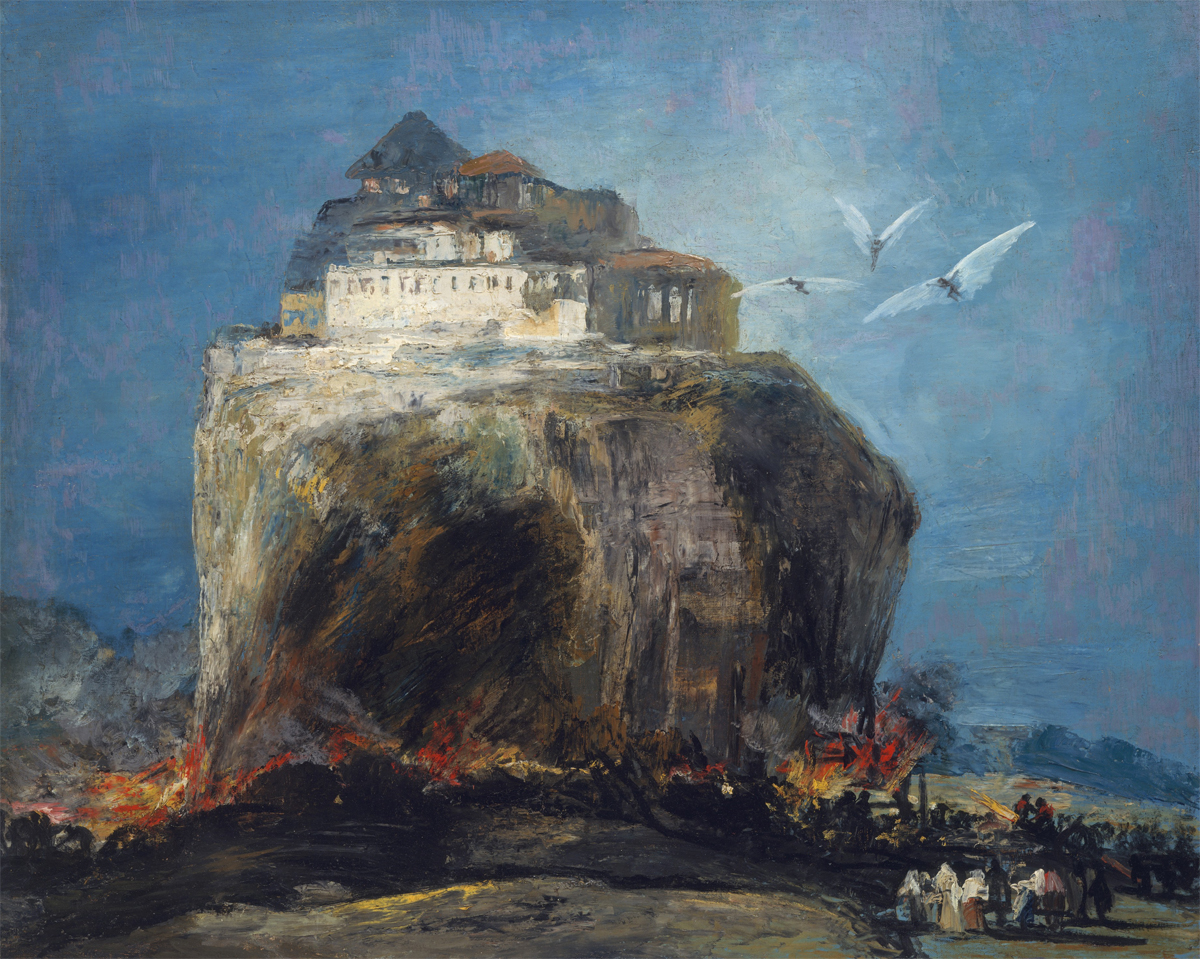
A City on a Rock, in the style of Goya, 19th century. The Metropolitan Museum of Art, H. O. Havemeyer Collection, Bequest of Mrs. H. O. Havemeyer, 1929.
Shadowed by the glowing monuments of the Acropolis spread ancient Athens’ labyrinth of dusty alleys and mean hovels. Away from the palazzi of Renaissance Venice’s Grand Canal lay the Jewish ghetto. Behind the elegant shop-lined boulevards leading out of the Exchange District of nineteenth-century Manchester festered the “misery and grime” that Friedrich Engels called the “complement” of wealth. Every successful story of gentrification in our contemporary cities is also a story of displacement and banishment. Engels’ The Condition of the Working Class in England in 1844 tried to make the unseen seen by leading his reader behind those facades. Similar aspirations impelled Eugène Sue’s ten-volume The Mysteries of Paris (1842–43); the writings and activism of Jane Addams and other Progressive Era reformers; Ralph Ellison’s Invisible Man (1952); George Orwell’s Down and Out in Paris and London (1933); Jacob Riis’ photographs and descriptions of New York slums in How the Other Half Lives (1890); and many other such works right up to contemporary urbanists like Mike Davis, Sharon Zukin, and David Harvey. And of course, the people consigned to the margins have made themselves heard and seen, in art, literature, and music, in politics, and in spontaneous, sometimes riotous actions. Decades of political activism and cultural sensitization have perhaps made it somewhat more difficult to look right through another person. Still, even if the processes that decide who and what should be visible and what should not in the cities of Europe and North America have become more subtle with the passage of time, they continue to be exercises of power that not only shape the look of our cities but also determine the social reality of urban life.
The city seen from on high, its unruliness tidied by distance, its mobility captured in a frieze, its impact on all five senses reduced to disembodied vision, will always be different from the city we view in the street, amid people, among buildings. Many a Hollywood movie begins with a sweeping aerial shot of the city, but to tell the story the camera descends to the ground, where we live and see and know the flickering ambivalence of city life, with its warmth and fright, loneliness and comfort. This is ultimately the conundrum that the city of Irene poses for Marco Polo. Like the task of getting the camera’s focus right, it is in the end a matter of optics. We periodically need the view from the plateau, if only for the moments of clarity it affords, but it is not Irene we have to work and fight for. Rather, our concern should be with the choreography of our daily ballet, down here on the streets, with everyone all the time.
